Teaching activities must be based on the students' cognitive development level and the existing experienced knowledge, thus, students' personal knowledge, students' life world and are also the important curriculum resources except textbook.A.game activit
题目
Teaching activities must be based on the students' cognitive development level and the existing experienced knowledge, thus, students' personal knowledge, students' life world and are also the important curriculum resources except textbook.
A.game activities
B.labour activities
C.attitude
D.direct experience
B.labour activities
C.attitude
D.direct experience
相似考题
参考答案和解析
答案:D
解析:
考查教学活动。教学活动必须建立在学生的认知发展水平和已有的知识经验基础之上。因此.学生的个人知识储备、生活世界和直接经验都是重要的课程资源。所以D项正确。
更多“ Teaching activities must be based on the students' cognitive development level and the existing experienced knowledge, thus, students' personal knowledge, students' life world and are also the impor”相关问题
-
第1题:
Which of the following is true of formative assessment?A.Mainly based on testing.
B.Done mostly at the end of a learning period.
C.Mainly for testing students’knowledge and skill.
D.Focused on students’learning progress.答案:D解析:本题考查形成性评价。
形成性评价强调的是学生学习的过程,而不是结果。英语教学应以形成性评价为主,而不是以总结性评价为主。综上,D选项正确。
A选项,以测试为基础。不合题意,故排除。
B选项,主要是在学期末,应为总结性评价,不合题意,故排除。
C选项,主要测试学生的知识和技能。不合题意,故排除。
故D选项正确。 -
第2题:
Which of the folIowing statements about take-based language teaching is NOT true?A.Students should be given tasks to perform or problems to solve in the classroom.
B.Students are task-driven.
C.Task-based language teaching is student-centered.
D.Task-based language teaching is teacher-centered.答案:D解析:考查任务型语言教学。任务型语言教学以学生为主体,以任务为中心,学生通过参与和完成一系列的任务来习得语言知识。任务型教学法的基本学习步骤分为前任务(pre.task)、任务环(task cvcle)和语言聚焦(1anguage focus)三个部分。故选D。 -
第3题:

二、考题解析
【教案】
Teaching aims:
Knowledge aim:
Students can master the usage of new phrases: in front of, across from, next to.
Ability aim:
Students can use these words to describe the way to some places and help others to find the way correctly in their life.
Emotional aim:
Through various activities, students can improve their oral ability and cooperative spirit.
Key and difficult point:
Key Point: students can understand the meaning of these phrases and use them to describe the way to some places.
Difficult Point: students can apply the knowledge in their daily life and also improve their speaking skills and cooperative spirits through different activities.
Teaching procedure:
Step 1: Warming-up
1. Greetings.
2. Show students some pictures of the famous scenic spots in our city. And ask them two questions: Q1: Where are these famous places?
Q2: Do you know how to give directions to others in English?
Step 2: Presentation
1. Set a situation that our old friend Tommy is visiting our city, and he wants to go some places. Ask students to help him find his way based on the map on the blackboard.
2. Ask students to listen to the tape and answer the following questions. They will be divided into three groups, and each group need to answer one question. In this process, the teacher teaches students new phrases through visual demonstration.
Q1: Where’s the library?
Q2: Where’s the park?
Q3: Where’s the pay phone?
Step 3: Practice
1. Pair work. Ask students work in pairs. One acts as A, and the other acts as B. They need to practice the dialogue, and two pairs will be invited to have a show in the front.
2. Describe the pictures. Students need to describe how to get to the places on the pictures by using these phrases.
Step4: Production
Do a survey: ask students to investigate the location of their partners’ homes and write down the results, some volunteers will be invited to do a report.
Step5: Summary and Homework
Summary: ask a student to conclude the content of the lesson and summarize with the whole class.
Homework: ask students to draw a map about the way from their homes to school and describe it to their parents or friends.
Blackboard design:

1. What teaching methods are used in your class?
2. How do you organize students to make a survey?答案:解析:1.
In my class, I mainly make use of three teaching methods, that is, communicative approach, task-based language teaching method and situational teaching method.
As for communicative approach, as you heard, this method is used in the whole class. Firstly, I ask students several questions, and invite some of them to answer the questions. This is teacher-student communication. Also, I organize several activities to help students communicate with each other, like role play and survey. These activities help students cultivate the ability of communication and co-operation.
As for task-based language teaching method, in the presentation part, I ask students to listen to the tape and finish related exercises. Students can know new knowledge through this task.
The last one is situational teaching method. Since the content of this lesson is closely related to students’ daily life, I set a real situation to teach the new knowledge. Students are easily attracted to the class.
3.
In my class, I usually organize students to do a survey by the following five steps:
First, I will tell students what the topic is and how much time they will have for this activity.
Next, I will divide them into several groups and ask them to take their time.
During their discussion, I will walk around and listen to their ideas, also I will give them some help if necessary.
When time is up, some volunteers will be invited to do reports at the front.
Last, proper evaluation will be given. -
第4题:

二、考题解析
【教案】
Teaching aims:
Knowledge aim:
Students will master the expression of date and the sentence structure: -What is ...’s birthday? -It is ...
Ability aim:
Students will improve their abilities of speaking and listening.
Emotional aim:
Students will be more confident in speaking English.
Key and difficult point:
Key Point: Students will master how to express a date in English.
Difficult Point: Students will use the sentence structure in daily life.
Teaching procedure:
Step 1: Warming-up
1. Greetings.
2. Ask students if today is anyone’s birthday. And invite the whole class to sing a ‘Happy Birthday’ song to him or her.
Step 2: Pre-listening
1. Review the knowledge about ordinal numeral: write some numbers on the blackboard and ask students to change the cardinal numeral into ordinal numeral.
2. Ask students to look at the picture in the textbook to predict what the dialogue may be about.
Step 3: While-listening
1st listening: Ask students to listen to the tape for the first time and check if their prediction is correct or not.
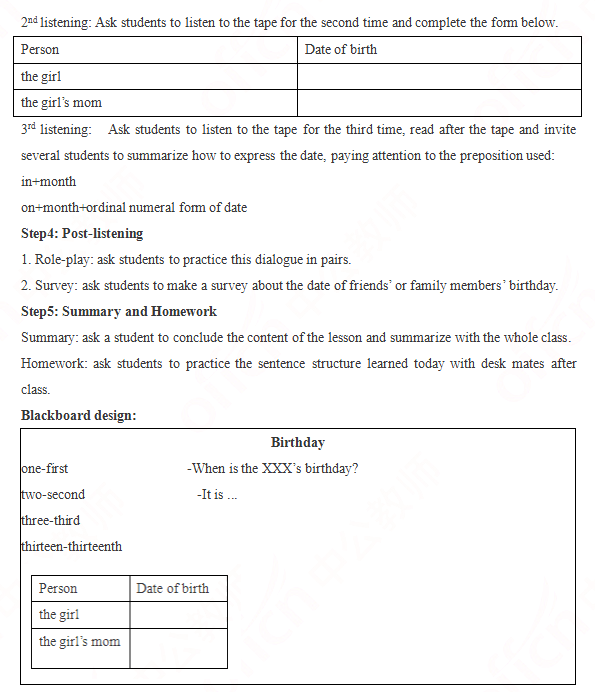
答案:解析:暂无解析 -
第5题:

二、考题解析
【教案】
Teaching Aims:
Knowledge aim: Students will master the words and expressions to describe their favourite club and explain their personal taste for club.
Ability aim: Students can express their favourite things and communicate with others around the given topic.
Emotional aim: Students will express themselves and show their personalities to the others with confidence.
Teaching Key Points:
Students can express their personal choices for clubs in English.
Teaching Difficult Points:
Students can express themselves correctly and fluently and gain the confidence of speaking English.
Teaching Methods:
Communicative teaching method, task-based teaching method and audiolingual teaching method.
Teaching Aids:
Video, Blackboard and so on.
Teaching Procedures:
Step 1: Warming-up
1.Greeting with with the students and show them a picture on the screen. The content of the picture is a entry test question of high-IQ club Mensa, which is very hard.
2.Show students a video about Mensa club -- a high-IQ club in the world to lead to the main topic of this lesson -- clubs.
Step 2: Pre-speaking
1. Do a brainstorming about “various kinds of club they know” by asking the question “ Is there any club you know?”
2. Record the answer on the blackboard.
3.Introduce some new type of club like Home club,ACG-lover club and Fit club to the students.
Step 3: While-speaking
Divide students into groups of four and ask them to do a survey about “ Which club do you like?” and make a chart according to the discussion result.
During the survey, try to briefly explain the reason why they like this club. Give them ten minutes.
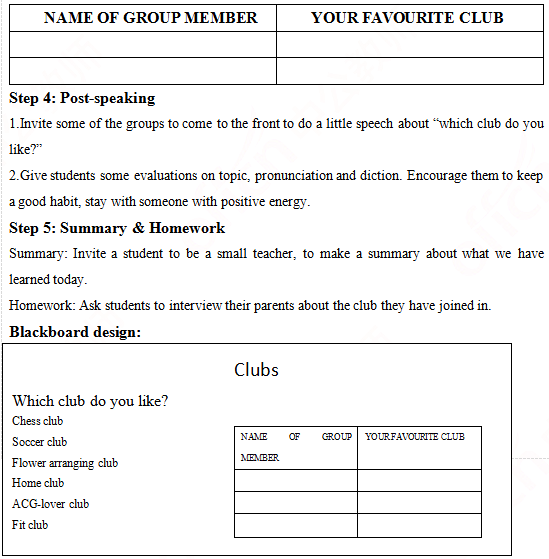 答案:解析:暂无解析
答案:解析:暂无解析 -
第6题:
初中英语《Lin Fei's daily life?》
一、考题回顾
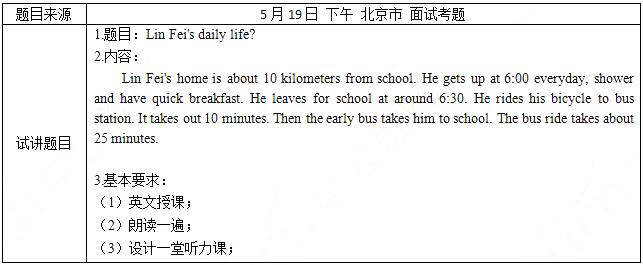
二、考题解析
【教案】
Teaching Aims:
Knowledge aim: Students will be able to describe their daily life and acquire some knowledge about listening strategies.题目来源于考生回忆
Ability aim: Students can obtain the main idea quickly from the listening material and develop the ability of grasping detail information.
Emotional aim: Students can foster the interest and desire of learning English, and be fond of taking part in kinds of practical activities.
Teaching Key Points:
Students can get the main idea and useful information from the listening material.
Teaching Difficult Points:
Students can apply these skills in their listening and apply these expression in their daily communication.
Teaching Methods:
Communicative teaching method, task-based teaching method, audio-lingual teaching method.
Teaching Aids:题目来源于考生回忆
PPT, Blackboard, recorder and so on
Teaching Procedures:
Step 1: Warming up
1.Greetings
2.Sing an English song It' my life, invite the whole students to clap when singing together and lead to the topic.
Step 2: Pre-listening
1.Free talk: Give students three minutes to talk about their own daily life and invite them to share it.
2.Prediction: Let students work in pairs and ask them to predict Lin Fei's daily life.
Step 3: While-listening
1. Listen to the tape for the first time and ask them when Lin Fei gets up and when he goes to school, then let students to share answers.题目来源于考生回忆
2.Listen to the tape for the second time and ask them to fill in the chart, then invite them to share their answers.
Step 4: Production
1.Retelling: Ask students to retell Lin Fei's daily life with the help of the chat in their own words, and teacher will give them 3 minutes to prepare it and 3 minutes later, invite some students to share their retelling in the front.
2.Survey: Let students discuss their own daily life in the group of four and make a report in the form of chart. 8 minutes later teacher invites some groups to share the result of their reports.
Step 5: Summary & Homework
Summary : Invite a little teacher to help teacher make a summary of this class.
Homework: Let students introduce their daily life to their parents and make a share in the next class.
Blackboard design:
 答案:解析:暂无解析
答案:解析:暂无解析 -
第7题:

二、考题解析
【教案】
Teaching Aims:
Knowledge aim: Students will be able to describe their summer holiday and acquire some knowledge about listening strategies.
Ability aim: Students can obtain the main idea quickly from the listening material and develop the ability of grasping detail information.
Emotional aim: Students can foster their interest and desire of learning English, and be fond of taking part in kinds of practical activities.
Teaching Key Points:
Students can get the main idea and useful information from the listening material.
Teaching Difficult Points:
Students can apply these skills in their listening and apply these expression in their daily communication.
Teaching Methods:
Communicative teaching method, task-based teaching method, audio-lingual teaching method.
Teaching Aids:
PPT, Blackboard, recorder and so on
Teaching Procedures:
Step 1: Warming up
1.Greetings
2.Sing an English song Summer Holiday, invite the whole students to clap when singing together and lead to the topic.
Step 2: Pre-listening
1.Brainstorm: Give students 3 minutes to say something about summer holiday as much as they can.
2.Clean up obstacle:Use pictures to teach students some difficult words or explain some words by English explanation.
Step 3: While-listening
1. Listen to the tape for the first time and ask them what the passage is mainly about, then let students share their ideas.
2.Listen to the tape for the second time and ask them to fill in the chart, then invite them to share their answers.
Step 4: Post-listening
1.Discussion: Ask students to discuss what they will do this summer holiday with their partners, and teacher will give them 3 minutes to prepare it and 3 minutes later, invite some students to share their own summer holiday in the front.
2.Report: Let students to write down plans of their own summer holiday with the key words and key sentences that they have learned today, 8 minutes later teacher invites some students to share the result of their reports.
Step 5: Summary & Homework
Summary : Invite a little teacher to help teacher make a summary of this class.
Homework: Let students prefect their plans of summer holiday and share with their parents.
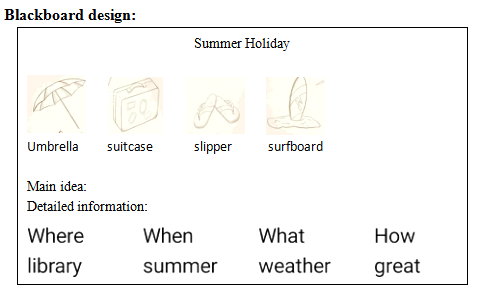 答案:解析:暂无解析
答案:解析:暂无解析 -
第8题:

二、考题解析
【教案】
Teaching Aims:
Knowledge aim: Students will master the sentence structure “We have great bags for only ¥12! we have....for only....; You can buy...for only .... ”.
Ability aim: Students can use these sentence structures to apply in their daily life.
Emotional aim: Students will improve their confidence of learning English and not afraid of speaking English in Class.
Teaching Key Points:
Students know the expressions about describing great sale and master the sentence structure.
Teaching Difficult Points:
Students can apply the expressions into daily communication.
Teaching Methods:
Communicative teaching method, task-based teaching method, situational teaching method.
Teaching Aids:
PPT, Blackboard and so on
Teaching Procedures:
Step 1: Warming up
1.Greetings
2.Play a video about an advertisement of Huawei phone and invite students to talk about the content of this video.Then the teacher leads in the topic of “Huaxing’s great sale.”
Step 2: Pre-speaking
1.Show two pictures about Huaxing store and its great sale advertisement.
2.Let students listen to the tape and find out what things are at great sale.
3.Ask students to listen to the tape again and collect the useful expressions about great sale.
Step 3:While-speaking
1. Ask students to read Huaxing’s store’s advertisement actively and vividly.
2. Let students talk about the expressions of great sale.
3. Role-play: students work in pairs to make conversation.Suppose there is a situation that you own a store. One student is shop assistant, the other students is customer. Teacher will give them 8 minutes to prepare it.
Step 4: Post-speaking
Share and evaluation: Invite some students to perform the conversation in the front.
Step 5: Summary & Homework
Summary: let them look at the blackboard and summarize this class.
Homework: Ask students to design a poster of their own store’s great sale and share it next class.
Blackboard design:
 答案:解析:暂无解析
答案:解析:暂无解析 -
第9题:

二、考题解析
【教案】
Teaching Aims:
Knowledge aim: Students will master the words “long, small,short, ears, eyes mouth,tail...”
Ability aim: Students can get the key information about rabbit and use the words to describe other animals.
Emotional aim: Students will improve their interest in English.
Teaching Key Points:
Students can understand the meaning of the words“long, small short” and use them to describe other animals.
Teaching Difficult Points:
Cultivate students awareness of loving animals and protecting animals.
Teaching Methods:
TPR teaching method, Communicative teaching method, task-based teaching method.
Teaching Aids:
Pictures, Blackboard and so on.
Teaching Procedures:
Step 1: Warming up
1.Greetings
2.Let students guess a riddle about rabbits. (Teacher need to make some actions to help students guess the answer- rabbit) and then lead in the topic “A rabbit”.
Step 2: Pre-reading
1. Show Students different pictures of rabbits to let students discover the common points.
2. Invite two students to try to describe rabbits in their own words.
3. Teach students these words “ tail, mouth ,ears,eyes”
Step 3: While-reading
1.Let students read the sentences and circle the words that are used to describe rabbits and invite one student to share.
2.Read them again and find out what part of the rabbits do they describe? After that,invite two students to write and draw a picture on the blackboard.
Step 4: Post-reading
Make a survey: Let students work in group of four. They’ll be given 15 minutes to ask each other about what are they favorite animals and fill in the survey table. After that, invite some students to share their survey result by intimating the animals in front of the blackboard.
Step 5: Summary & Homework
Summary: Invite a student to be a small teacher, to make a summary about what we have learned today.
Homework: Draw a picture of your favorite animals and share it to your friends.
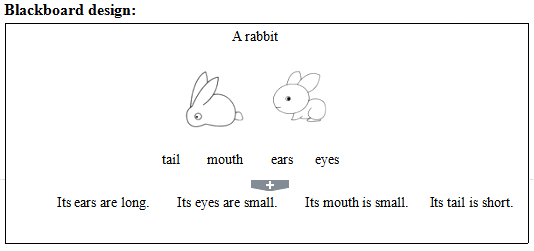 答案:解析:暂无解析
答案:解析:暂无解析 -
第10题:
Which of the following is true of formative assessment ( )
A、 Mainly based on testing.
B、 Done mostly at the end of a learning perio
D、
C、 Mainly for testing students’ knowledge and skill.
D、 Focused on the progress of students.答案:D解析:形成性评价强调的是学生学习的过程,而不是结果。 -
第11题:
单选题What’s the overall goal of English teaching in basic education stage? _____AIncrease students’ vocabulary and grammar of the knowledge.
BImprove the students’ English learning and foreign cultural interesting.
CCultivate the students’ ability of listening and spoken English.
DCultivate students’ comprehensive capability of language.
正确答案: C解析:
基础教育阶段英语教学的总体目标是培养学生的综合语言运用能力。 -
第12题:
单选题Teaching activities must be based on the students’ cognitive development level and the existing experienced knowledge, thus, students’ personal knowledge, students’ life world and _____ are also the important curriculum resources except textbook.Agame activities
Blabour activities
Cindirect experience
Ddirect experience
正确答案: A解析:
direct experience直接经验。学生的生活世界和直接经验也是重要的教学资源。 -
第13题:
Teaching activities must be based on the students' cognitive development level and theexistingexperiencedknowledge,thus,students'personal knowledge,students'
Lifeworld and__________ are also the important curriculum resources except textbook.A.game activities
B.labour activities
C.attitudes
D.direct experience答案:D解析:考查教学活动。教学活动必须建立在学生的认知发展水平和已有的知识经验基础之上。因此,学生的个人知识储备、生活世界和直接经验都是重要的课程资源.所以D项正确。 -
第14题:
Teaching activities must be based on the students' cognitive development level and the existing experienced knowledge, thus, students' personal knowledge, students' life world and__________ are also the important curriculum resources except textbook.A.game activities
B.labour activities
C.attitude
D.direct experience答案:D解析:考查教学活动。教学活动必须建立在学生的认知发展水平和已有的知识经验基础之上。因此,学生的个人知识储备、生活世界和直接经验都是重要的课程资源。所以D项正确。 -
第15题:

二、考题解析
【教案】
Teaching aims:
Knowledge aim:
Students will know the structure of letter and know how to invite and refuse others.
Ability aim:
Students will improve their reading abilities such as skimming and scanning.
Emotional aim:
Students will use what we have learned into their daily life.
Key and difficult point:
Key Point: Students will know how to invite and refuse others.
Difficult Point: Students will be more confident in speaking English and improve their reading skills.
Teaching procedure:
Step 1: Warming-up
1. Greetings.
2.Play a video of Dear John Letter to lead in the lesson.
Step 2: Pre-reading
Ask students to predict what we will learn today according to the video.
Step 3: While-reading
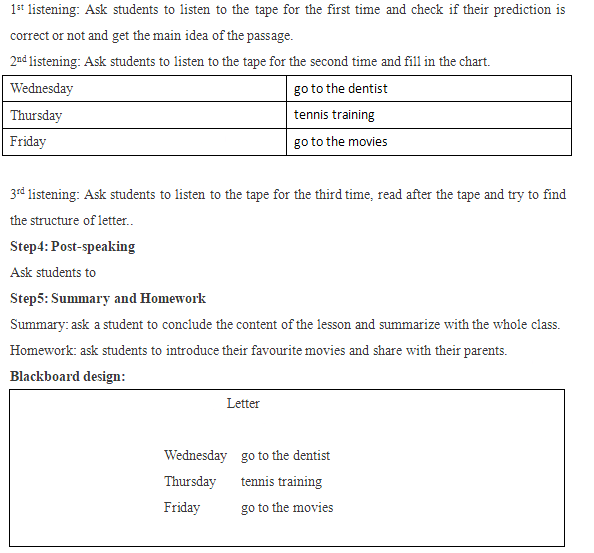
1.How to improve students’ reading ability?
2.Which school did you graduate?答案:解析:1.
The topic should be interesting, which can arouse the interest of students In the class, teachers should give students’ subjectivity to the full play and give them more chance to communicate with each other. And organize various activities to encourage them to express themselves.
2.
I graduated from ...and English is my major. After four years’ study, I have ,mastered the basic professional knowledge in English and I was also award with second prize scholarship. I actively participated various community activities which broaden my horizon. I also engage in teaching practice, which enrich my teaching experience. -
第16题:

二、考题解析
【教案】
Teaching Aims:
Knowledge aim: Students will be able to describe their daily life and acquire some knowledge about listening strategies.题目来源于考生回忆
Ability aim: Students can obtain the main idea quickly from the listening material and develop the ability of grasping detail information.
Emotional aim: Students can foster the interest and desire of learning English, and be fond of taking part in kinds of practical activities.
Teaching Key Points:
Students can get the main idea and useful information from the listening material.
Teaching Difficult Points:
Students can apply these skills in their listening and apply these expression in their daily communication.
Teaching Methods:
Communicative teaching method, task-based teaching method, audio-lingual teaching method.
Teaching Aids:题目来源于考生回忆
PPT, Blackboard, recorder and so on
Teaching Procedures:
Step 1: Warming up
1.Greetings
2.Sing an English song It' my life, invite the whole students to clap when singing together and lead to the topic.
Step 2: Pre-listening
1.Free talk: Give students three minutes to talk about their own daily life and invite them to share it.
2.Prediction: Let students work in pairs and ask them to predict Lin Fei's daily life.
Step 3: While-listening
1. Listen to the tape for the first time and ask them when Lin Fei gets up and when he goes to school, then let students to share answers.题目来源于考生回忆
2.Listen to the tape for the second time and ask them to fill in the chart, then invite them to share their answers.
Step 4: Production
1.Retelling: Ask students to retell Lin Fei's daily life with the help of the chat in their own words, and teacher will give them 3 minutes to prepare it and 3 minutes later, invite some students to share their retelling in the front.
2.Survey: Let students discuss their own daily life in the group of four and make a report in the form of chart. 8 minutes later teacher invites some groups to share the result of their reports.
Step 5: Summary & Homework
Summary : Invite a little teacher to help teacher make a summary of this class.
Homework: Let students introduce their daily life to their parents and make a share in the next class.
Blackboard design:
 答案:解析:暂无解析
答案:解析:暂无解析 -
第17题:

二、考题解析
【教学过程】
Teaching aims:
Knowledge aim:
Students can get some knowledge about the city Pompeii.
Ability aim:
Students can use the past perfect tense to describe a place.
Emotional aim:
Students will be interested in foreign history and have the desire to explore unknown things.
Key and difficult point:
Key Point: Students can fully understand the passage and find required information.
Difficult Point: Students can cultivate the curiosity towards foreign history.
Teaching procedure:
Step 1: Warming-up
1. Greet the students.
2. Show some pictures of culture relics and introduce some background knowledge about them.
Step 2: Pre-reading
1. Use pictures and videos to teach new words: Volcanic eruption, buried, event, etc.
2. Exhibit the picture of Pompeii and ask students whether they know something about this city. Invite several people to briefly talk about it.
Step 3: While-reading
1. Read the text quickly and find the main content of the passage.
2. Read it for the second time. Students need to complete the timeline after reading the passage.答案:解析: -
第18题:

二、考题解析
【教案】
Teaching Aims:
Knowledge aim: Students will master the content about hobbies.
Ability aim: Students can improve their writing ability about hobbies, such as drawing.
Emotional aim: Students will foster a hobby and know how to keep it.
Teaching Key Points:
Students know the content about hobbies and can improve their writing ability about hobbies.
Teaching Difficult Points:
Students can learn how to write, basing on their hobbies..
Teaching Methods:
Communicative teaching method, task-based teaching method, situational teaching method.
Teaching Aids:
PPT, Blackboard and so on
Teaching Procedures:
Step 1: Warming up
1.Greetings
2. Show two pictures about hobbies , ask all students to observe and describe.
Step 2: Pre-writing
1. Divide students into two groups, group A and group B and ask them to read the the dialogue.
2. Lead students to summary the main idea.
3.Read the dialogue by themselves again, then ask them some questions to get details.
(1) What are they fond of?
(2) How about drawing, what can it teach you?
(3) Where will they go?
4. Ask students to work in groups and discuss, do a survey on hobbies and reason, collecting key points.
Step 3: While-writing
Students write an article within 20 minutes.
Step 4: Post-writing
1.Self editing: students work in pairs to check if there are faults in spelling and grammar.
2.Sharing: choose 1-2 writing and show it on the screen.
3.Evaluating: appreciate and give comments.
Step 5: Summary & Homework
Summary : students look at the blackboard and summarize this class.
Homework:students talk about their hobbies to their friends or parents.
Blackboard design:
 答案:解析:暂无解析
答案:解析:暂无解析 -
第19题:

二、考题解析
【教案】
Teaching aims:
Knowledge aims:
Students will know how to describe a day using proper conjunctions and tense.
Students will master some words, such as waste, value... and a sentence structure: I usually + simple present tense.
Ability aim:
Students will improve their abilities of speaking and listening.
Emotional aim:
Students will be more confident in speaking English.
Key and difficult point:
Key Point: Students will know how to introduce a day in English.
Difficult Point: Students will use the sentence structure in real communicative situation.
Teaching procedure:
Step 1: Warming-up
1. Greetings.
2. Play a video about Tom’s day and ask students what kind of information have they caught.
Step 2: Pre-listening
1. Review the knowledge about simple present tense. Ask students to make sentences using simple present tense.
2.Using pictures to explain some words: waste-value, brush.
Step 3: While-listening
1st listening: Ask students to listen to the tape for the first time and try to get the main idea of the passage and underline the conjunctions used.
2nd listening: Ask students to listen to the tape for the second time and complete the timetable below.
 答案:解析:暂无解析
答案:解析:暂无解析 -
第20题:

二、考题解析
【教案】
Teaching Aims:
Knowledge aims:
(1) Students will master two difficult words,such as universal, unfamiliar.
(2) Students will learn knowledge about body language.
Ability aim: Students are able to understand the meaning of body language in their daily life and can improve the ability in scanning and skimming.
Emotional aim: Students can show their feelings with body language in reality.
Teaching Key Points:
Students can know the meaning of various body languages.
Teaching Difficult Points:
Students are able to express their feelings with body language in reality..
Teaching Methods:
Communicative teaching method, task-based teaching method, situational teaching method.
Teaching Aids:
PPT, Blackboard and so on
Teaching Procedures:
Step 1: Warming up
1.Greetings
2.Play a clip from a popular American TV series Lie to me (many body languages are shown in it), invite two students to talk about their feelings.
Step 2: Pre-reading
1.Let’s say. Lead students to talk about body languages that we usually see in our daily life.
Step 3: While-reading
1.Fast reading. Read the passage for the first time and ask students to summarize the main idea.
2.Careful reading. Read the passage for the second time with questions.
(1) How many body languages are mentioned in the passage when we meet others?
(2) what is the difference in different countries? Talk it in details.
Step 4: Post-reading
Divide all students into several groups and give them five minutes to discuss other body languages that we usually use. After that, invite three students to share.
Step 5: Summary & Homework
Summary : students look at the blackboard and summarize this class.
Homework:students surf the internet and collect more information about body language..
Blackboard design:
 答案:解析:暂无解析
答案:解析:暂无解析 -
第21题:
Which of the following is true of formative assessment ( )
A. Mainly based on testing.
B. Done mostly at the end of a learning period.
C. Mainly for testing students’ knowledge and skill.
D. Focused on the progress of students.答案:D解析:形成性评价强调的是学生学习的过程,而不是结果。 -
第22题:
单选题If a university is to be of any use, it should prepare the students for an intellectual career by ______.Aimparting knowledge and developing skills
Bdeveloping students’ independence in thinking
Cdisciplining the students in their subject fields
Dpromoting the imagination in connecting details with general principles
正确答案: A解析:
细节题。由第三段最后一句可知,通过大学的准备,学生进入到有技术性的“学徒期”时,已经锻炼了他们的想象力,可以将细节与一般原则联系起来。这是作者所赞同的、认为大学应当起的作用。故D项为正确答案。 -
第23题:
单选题What’s the starting point and destination of the English course? _____AImpart the knowledge.
BThe students’ development.
CLanguage usage.
DHabit formation.
正确答案: D解析:
英语课程的出发点和归宿是学生的发展。
